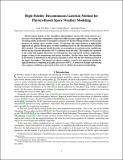High-Fidelity Discontinuous Galerkin Method for Physics-Based Space Weather Modeling
Author(s)
Vila-Pérez, Jordi; Nguyen, Cuong; Peraire, Jaime
DownloadJVP2023_AIAA_SpaceWeather.pdf (8.924Mb)
Open Access Policy
Open Access Policy
Creative Commons Attribution-Noncommercial-Share Alike
Terms of use
Metadata
Show full item recordAbstract
Physics-based models of the ionosphere–thermosphere system have been devised as a necessary tool to predict atmospheric outputs for different space applications. For example, for obtaining reliable predictions of atmospheric drag for low-Earth orbiting satellites or forecasting purposes of extreme space weather events. To this end, this study proposes a high-fidelity approach for physics-based space weather modeling based on the discontinuous Galerkin (DG) method. The proposed model describes an atmosphere in non-hydrostatic equilibrium
driven by the extreme ultraviolet (EUV) radiation from the Sun. The multiscale variations in the radial and angular directions are managed in a non-segregated strategy, employing a proper scaling of the momentum and energy variables. On the other hand, the logarithm of the density is introduced as the primary quantity to deal with the low densities present in the upper atmosphere. The numerical scheme combines a matrix-free approach suitable for high-performance computing on graphic processors (GPUs). A numerical example reproducing solar equinox conditions is presented in this work to validate the proposed methodology.
Description
AIAA SCITECH 2023 Forum 23-27 January 2023 National Harbor, MD & Online
Date issued
2023-01-19Department
Massachusetts Institute of Technology. Department of Aeronautics and AstronauticsPublisher
American Institute of Aeronautics and Astronautics
Citation
Jordi Vila-Pérez, Cuong Nguyen and Jaime Peraire. "High-Fidelity Discontinuous Galerkin Method for Physics-Based Space Weather Modeling," AIAA 2023-1958. AIAA SCITECH 2023 Forum. January 2023.
Version: Author's final manuscript